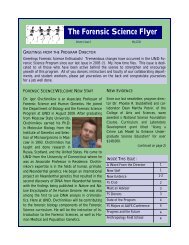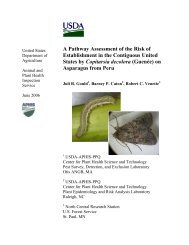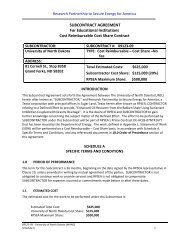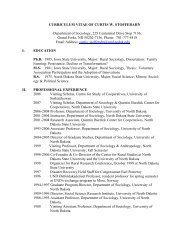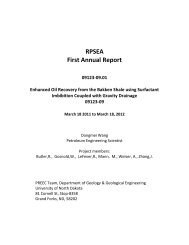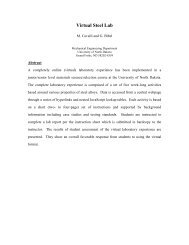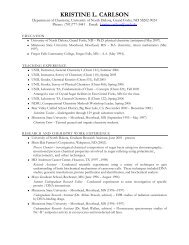Dirigent proteins in conifer defense: gene discovery, phylogeny, and ...
Dirigent proteins in conifer defense: gene discovery, phylogeny, and ...
Dirigent proteins in conifer defense: gene discovery, phylogeny, and ...
You also want an ePaper? Increase the reach of your titles
YUMPU automatically turns print PDFs into web optimized ePapers that Google loves.
38<br />
anatomical level. A role for PP cells <strong>in</strong> <strong>conifer</strong><br />
<strong>defense</strong> has been established <strong>in</strong> several studies<br />
exam<strong>in</strong><strong>in</strong>g the anatomical response to mechanical<br />
wound<strong>in</strong>g, bark beetle attack, or fungal pathogens<br />
<strong>in</strong> Norway spruce. These treatments resulted <strong>in</strong> an<br />
<strong>in</strong>creased number <strong>and</strong> size of PP cells, <strong>and</strong> an<br />
<strong>in</strong>creased size <strong>and</strong> altered pattern of distribution of<br />
phenolic bodies <strong>in</strong> PP cells, with marked differences<br />
between trees resistant or sensitive to attack<br />
(Franceschi et al., 1998, 2000; Krokene et al., 2003;<br />
Nagy et al., 2000, 2004). PP cells are proposed to<br />
be active <strong>in</strong> the synthesis <strong>and</strong> storage of phenolic<br />
<strong>defense</strong> compounds <strong>in</strong> response to wound<strong>in</strong>g. This<br />
is based on autofluorescence under blue light of<br />
the contents of vacuoles of PP cells <strong>and</strong> the<br />
immunocytochemical localization of PAL to PP<br />
cells, primarily at the plasma membrane (Franceschi<br />
et al., 1998). PP cells sta<strong>in</strong> more darkly<br />
approximately 3 weeks after fungal <strong>in</strong>oculation,<br />
suggest<strong>in</strong>g there may also be a change <strong>in</strong> phenolic<br />
content, possibly alter<strong>in</strong>g solubility or toxicity<br />
(Franceschi et al., 2000). Although the composition<br />
of the phenolic content of the PP cells has not<br />
yet been characterized, <strong>and</strong> little is known concern<strong>in</strong>g<br />
<strong>in</strong>duced <strong>gene</strong> expression for the formation<br />
of phenolic <strong>defense</strong> compounds <strong>in</strong> spruce, the DIR<br />
family may play a role <strong>in</strong> this <strong>defense</strong> mechanism.<br />
DIR <strong>prote<strong>in</strong>s</strong> have been proposed to control<br />
the monolignol coupl<strong>in</strong>g reactions lead<strong>in</strong>g to the<br />
formation of lign<strong>in</strong> (Dav<strong>in</strong> et al., 1997). Several<br />
weeks after <strong>in</strong>oculation of Norway spruce bark<br />
<strong>and</strong> cambium with the bark beetle associated<br />
fungal pathogen Ceratocystis polonica, cells surround<strong>in</strong>g<br />
the <strong>in</strong>oculation site become partially or<br />
completely lignified (Franceschi et al., 2000; Nagy<br />
et al., 2000). This lignification likely serves to<br />
strengthen cell walls to help conta<strong>in</strong> the spread of<br />
the fungal pathogen, possibly via DIR <strong>gene</strong><br />
<strong>in</strong>duction <strong>and</strong>/or DIR activity. Accord<strong>in</strong>g to the<br />
model of monolignol coupl<strong>in</strong>g proposed by<br />
Dav<strong>in</strong> et al. (1997), stereoselective bimolecular<br />
coupl<strong>in</strong>g by DIR <strong>prote<strong>in</strong>s</strong> must be preceded by<br />
one-electron oxidation of the monolignols by a<br />
peroxidase or laccase enzyme. In addition to<br />
<strong>in</strong>duced levels of DIR <strong>gene</strong>s, the Sitka spruce 16.7<br />
cDNA microarray profiles of wound- or <strong>in</strong>sect<strong>in</strong>duced<br />
bark tissues also revealed <strong>in</strong>duction of<br />
several laccase <strong>gene</strong>s with patterns of expression<br />
similar to DIR <strong>gene</strong>s (S. Ralph <strong>and</strong> J. Bohlmann,<br />
unpublished results). The concomitant <strong>in</strong>duction<br />
of numerous laccase-like array elements, <strong>in</strong> a<br />
temporal fashion analogous to the DIR transcripts,<br />
provides further support for a relationship<br />
between phenol oxidases <strong>and</strong> DIR <strong>prote<strong>in</strong>s</strong><br />
<strong>in</strong> the <strong>in</strong>duced <strong>defense</strong> response <strong>in</strong> stems of Sitka<br />
spruce.<br />
In conclusion, we identified a large family of<br />
DIR <strong>prote<strong>in</strong>s</strong> <strong>in</strong> the spruce transcriptome that<br />
resulted <strong>in</strong> the <strong>discovery</strong> of related clades of DIRlike<br />
<strong>prote<strong>in</strong>s</strong> of this large family of unique plant<br />
<strong>prote<strong>in</strong>s</strong>. Our data support a role of the DIR <strong>and</strong><br />
DIR-like <strong>gene</strong>s <strong>in</strong> constitutive <strong>and</strong> <strong>in</strong>sect-<strong>in</strong>duced<br />
<strong>defense</strong> aga<strong>in</strong>st weevils <strong>in</strong> Sitka spruce, which may<br />
also function aga<strong>in</strong>st other <strong>in</strong>sects such as bark<br />
beetles or <strong>in</strong>sect-associated pathogens. To our<br />
knowledge, the genome-wide <strong>discovery</strong> of spruce<br />
full-length <strong>and</strong> near full-length DIR <strong>and</strong> DIR-like<br />
cDNAs is the most comprehensive reported for any<br />
species to date. Together with the microarray <strong>and</strong><br />
real time PCR expression analysis reported here, it<br />
will provide an important platform for further<br />
<strong>in</strong>vestigation of this <strong>gene</strong> family for phenolic<br />
<strong>defense</strong>s aga<strong>in</strong>st <strong>in</strong>sects, <strong>in</strong> particular its role <strong>in</strong> cell<br />
wall strengthen<strong>in</strong>g <strong>and</strong> lignan formation <strong>in</strong> spruce<br />
<strong>defense</strong>, <strong>and</strong> a possible association with PP cells.<br />
Acknowledgements<br />
This work was supported by Genome British<br />
Columbia, Genome Canada, <strong>and</strong> the Prov<strong>in</strong>ce of<br />
British Columbia (grant to J.B.), by the Natural<br />
Science <strong>and</strong> Eng<strong>in</strong>eer<strong>in</strong>g Research Council of<br />
Canada (NSERC) (grants to J.B. <strong>and</strong> S.D.M.),<br />
<strong>and</strong> from a Canada Research Chair (CRC) <strong>in</strong><br />
wood <strong>and</strong> fiber quality (to S.D.M.). We thank<br />
Barry Jaquish, John K<strong>in</strong>g, Alv<strong>in</strong> Yanchuk from<br />
the BC M<strong>in</strong>istry of Forests, Victoria, for access<br />
to white spruce <strong>and</strong> Sitka spruce trees, <strong>and</strong> David<br />
Ellis, CellFor Inc., for <strong>in</strong>terior spruce seedl<strong>in</strong>gs.<br />
We thank Rene I. Alfaro from the Canadian Forest<br />
Service for access to weevils. We thank members<br />
of the Treenomix laboratory Sharon Jancsik,<br />
Krist<strong>in</strong> Rueffer, <strong>and</strong> Natalia Kolosova for excellent<br />
technical assistance with EST development,<br />
microarray work, <strong>and</strong> full-length cDNA clon<strong>in</strong>g,<br />
Dana Aeschliman for statistical support, <strong>and</strong><br />
Carol Ritl<strong>and</strong> for lab management. We thank<br />
Kim Rens<strong>in</strong>g for technical assistance with tissue<br />
section<strong>in</strong>g, David Kaplan for greenhouse support,<br />
<strong>and</strong> Ron Sederoff <strong>and</strong> Hesther Yueh for critical<br />
read<strong>in</strong>g of the manuscript.






